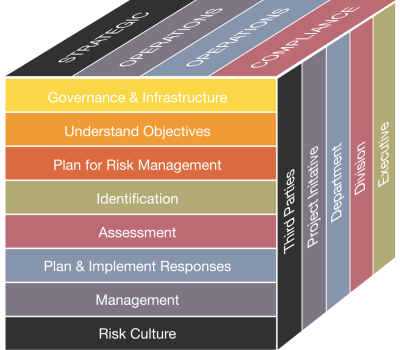Risk Management
From its inception, the Emirates Nuclear Energy Corporation (ENEC) has taken a proactive approach to risk management. Even before an Enterprise Risk Management (ERM) program was fully defined, ENEC’s Board of Directors and CEO were determined that potential threats and opportunities should be identified and actions taken to address those risks presenting the greatest potential impact on the success of the UAE Peaceful Nuclear Energy Program.
The ENEC Board Directors have the responsibility of oversight for the processes established to proactively identify, assess, manage, report and monitor material risks to achieve the corporation’s goals and objectives. ENEC’s Executive Risk Management Committee (ERMC) functions as Risk Counsel for the corporation and its Board. The ERMC:
- Periodically reviews the top priority Executive Risks (threats and opportunities) within ENEC to ensure they are effectively managed and recommends any additional management actions required.
- Reports Top Priority risks to the Board to make informed decisions
- Ensures existence and implementation of an appropriate framework and effective strategy to identify and manage risks within ENEC
- Provides oversight and ensures adequacy of the ERM methodology, processes and performance to ensure it is meeting business requirements, in line with globally recommended practices and complying with regulatory standards and guidance.
- Interacts with other Executive and Government Committees on the subject of ERM.
The ERM policy and procedure documents have been formalized through ENEC’s management system to facilitate and govern ERM’s integration with the business.
The risk management governance structure was established at the executive, divisional, and department levels to facilitate the escalation of risks and the embedding of ERM within the decision-making process.
In line with the risk management governance structure, standardized reporting requirements and formats were established, further enabling the embedding of an ERM Culture within the organization.
ENEC values the importance of identifying threats and opportunities using a combination of top-down and bottom-up techniques. ENEC uses a strategic filter, which means that the identified risks are filtered through ENEC’s strategies in order to ensure that ERM is focused on the key risks that may impact the Corporation’s strategic objectives and that the ERM process is fully integrated into the business process.
 |
ENEC exhibits best practice with regard to policy, process and infrastructure, which are complemented by the organizational Safety Culture which embraces risk management. The formalized ERM process has been established based on best practices from the IRM/AIRMIC/ALARM 2002, COSO ERM Framework 2004, ISO31000:2009, and the PMI, as well as incorporating lessons learned from practical experience on both nuclear projects and large, complex non-nuclear projects.
ENEC is currently building - and is committed to continue developing - a remarkable risk-management capability that compares well with its industry peers and beyond, both regionally and internationally. The implemented ERM framework, comprehensive Risk Culture building and training program show that we understand the type of skills and knowledge that our employees and teams need. The use of ERM Key Performance Indicators bodes well for ENEC’s future performance enhancement as a business.
